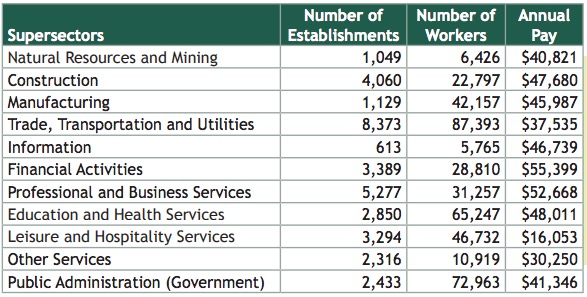I heard mention of the new Quarterly Census of Employment and Wages on the radio; Bob Mercer was kind enough to provide the link to the actual data on South Dakota’s jobs and pay. In 2016, average annual pay in South Dakota rose 2.5% to $41,168. Among the details:

- The lowest annual pay by far is in leisure and hospitality.
- The best-paying sectors are financial activities and professional/business services.
- The industries employing the most South Dakotans (as counted by those covered by unemployment insurance) are trade/transportation/utilities, government, and education health.
- The smallest employment sectors are information and natural resources/mining (that includes agriculture).
The Bureau of Labor Statistics provides a slightly higher preliminary average annual 2016 wage for South Dakota: $41,177. The national average annual wage in 2016 was $53,611. South Dakota thus earned 76.81% of the national average. We rank 48th in the nation; only folks in Idaho, Mississippi, and Montana make less. Minnesota ranks 13th.
I can hear South Dakota Republicans screaming cost of living! already. Let’s squash that argument again by putting the salary figures in context:
- The most recent BLS “Regional Price Parity” data available are for 2015.
- According to that RPP data, in 2015, buying stuff in South Dakota cost 88.2% of what buying stuff cost nationwide.
- In 2015, South Dakota’s average salary was $40,181.
- In 2015, the national average salary was $52,942.
- Divide our 2015 salary ($40,181) by our 2015 Regional Price Parity, and you find that South Dakotans had $45,557 of practical purchasing power.
- In 2015, our raw average pay was 75.90% of the national average, 48th in the nation.
- In 2015, our RPP-adjusted purchasing power was 86.05% of the national average, 44th in the nation.
Now if you’ll permit me to stretch the data a little, let’s apply to 2015 regional price parities to the preliminary 2016 average wages BLS reports. How do we compare to our neighbors?
| state | 2016 wage | 2015 RPP | 2016 wage adj RPP |
| North Dakota | $48,873 | 92.3 | $52,950 |
| Minnesota | $54,270 | 97.4 | $55,719 |
| Iowa | $44,910 | 90.3 | $49,734 |
| Nebraska | $43,606 | 90.6 | $48,130 |
| Wyoming | $44,974 | 96.2 | $46,751 |
| Montana | $40,730 | 94.8 | $42,964 |
| South Dakota | $41,177 | 88.2 | $46,686 |
We have the second-lowest average salary but also the lowest RPP in the region. Divide the former by the latter, and we expand our purchasing power advantage over Montana, almost catch up with Wyoming, but remain thousands of dollars behind our other four neighbors. Move from South Dakota to Minnesota, and the purchasing power of your average paycheck rises over 19%.
If I apply the 2015 RPPs to 2016 average wages, South Dakota moves up from 48th in the nation to 43rd. Minnesota moves up from 13th to 8th.
Whether we look at raw dollars or purchasing power based on regional price parities, South Dakota remains one of the hardest states in which to make a living.
Some positive context: Over the past decade, South Dakota has shown remarkable growth in average salary. In 2006, our average annual wage was $30,291, only 71.21% of the national average. From 2006 to 2016, South Dakota posted 35.94% growth in annual wages, the third-best growth in the nation. National growth was 26.04%; the two states that outgrew us were North Dakota at a well-oiled 56.06% and Washington at 37.60%. We’re still behind, but we’re catching up!
SDs twin, Mississippi, is always inseparable with SD, but I’m surprised to see Montana and Idaho at the bottom. (After seeing spectacular Glacier National Park, I would still take it over SD any day, a bit more progressive there).
Consider this. If things are cheaper to buy in South Dakota an enterprising group could figure a way to sell these cheaper things to people in other states. It would be profitable until SoDak catches up.
PS … notice that the only “blue” state in the list is leading. You really do have to spend money to make money, no matter what the “do it on the cheap” Republican lazy-lators tell ya’. New things and ideas attract money. Monetary surpluses are a symbol of things you don’t have. Investors see this.
I have had Minnesotans tell me they were surprised how expensive the Black Hills was for a place to live, and also have mentioned to me how Sioux Falls isn’t any less expensive than MN. They had been told the lie that SD is a cheap place to live. I tell them all about the extreme anti-lgbt right wing politics in SD and how they pay dirt wages.
Right, Jenny. South Dakota is a GREAT place to live and it has an untapped potential rarely realized elsewhere. But, it’s not cheaper to live. All things accounted for, people in SoDak don’t have any more money left over after the bills are paid than liberal states and they have a need to get away for vacations. Just ask Patty Powers how much of his real estate salesman money goes out of state every year. LOL (Thanks for coming to CO, Pat. Just for the scenery, huh? LOL)